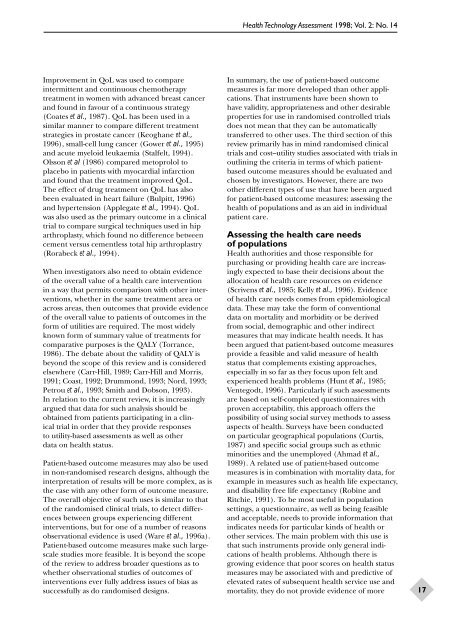Evaluating Patient-Based Outcome Measures - NIHR Health ...
Evaluating Patient-Based Outcome Measures - NIHR Health ...
Evaluating Patient-Based Outcome Measures - NIHR Health ...
You also want an ePaper? Increase the reach of your titles
YUMPU automatically turns print PDFs into web optimized ePapers that Google loves.
Improvement in QoL was used to compare<br />
intermittent and continuous chemotherapy<br />
treatment in women with advanced breast cancer<br />
and found in favour of a continuous strategy<br />
(Coates et al., 1987). QoL has been used in a<br />
similar manner to compare different treatment<br />
strategies in prostate cancer (Keoghane et al.,<br />
1996), small-cell lung cancer (Gower et al., 1995)<br />
and acute myeloid leukaemia (Stalfelt, 1994).<br />
Olsson et al (1986) compared metoprolol to<br />
placebo in patients with myocardial infarction<br />
and found that the treatment improved QoL.<br />
The effect of drug treatment on QoL has also<br />
been evaluated in heart failure (Bulpitt, 1996)<br />
and hypertension (Applegate et al., 1994). QoL<br />
was also used as the primary outcome in a clinical<br />
trial to compare surgical techniques used in hip<br />
arthroplasty, which found no difference between<br />
cement versus cementless total hip arthroplastry<br />
(Rorabeck et al., 1994).<br />
When investigators also need to obtain evidence<br />
of the overall value of a health care intervention<br />
in a way that permits comparison with other interventions,<br />
whether in the same treatment area or<br />
across areas, then outcomes that provide evidence<br />
of the overall value to patients of outcomes in the<br />
form of utilities are required. The most widely<br />
known form of summary value of treatments for<br />
comparative purposes is the QALY (Torrance,<br />
1986). The debate about the validity of QALY is<br />
beyond the scope of this review and is considered<br />
elsewhere (Carr-Hill, 1989; Carr-Hill and Morris,<br />
1991; Coast, 1992; Drummond, 1993; Nord, 1993;<br />
Petrou et al., 1993; Smith and Dobson, 1993).<br />
In relation to the current review, it is increasingly<br />
argued that data for such analysis should be<br />
obtained from patients participating in a clinical<br />
trial in order that they provide responses<br />
to utility-based assessments as well as other<br />
data on health status.<br />
<strong>Patient</strong>-based outcome measures may also be used<br />
in non-randomised research designs, although the<br />
interpretation of results will be more complex, as is<br />
the case with any other form of outcome measure.<br />
The overall objective of such uses is similar to that<br />
of the randomised clinical trials, to detect differences<br />
between groups experiencing different<br />
interventions, but for one of a number of reasons<br />
observational evidence is used (Ware et al., 1996a).<br />
<strong>Patient</strong>-based outcome measures make such largescale<br />
studies more feasible. It is beyond the scope<br />
of the review to address broader questions as to<br />
whether observational studies of outcomes of<br />
interventions ever fully address issues of bias as<br />
successfully as do randomised designs.<br />
<strong>Health</strong> Technology Assessment 1998; Vol. 2: No. 14<br />
In summary, the use of patient-based outcome<br />
measures is far more developed than other applications.<br />
That instruments have been shown to<br />
have validity, appropriateness and other desirable<br />
properties for use in randomised controlled trials<br />
does not mean that they can be automatically<br />
transferred to other uses. The third section of this<br />
review primarily has in mind randomised clinical<br />
trials and cost–utility studies associated with trials in<br />
outlining the criteria in terms of which patientbased<br />
outcome measures should be evaluated and<br />
chosen by investigators. However, there are two<br />
other different types of use that have been argued<br />
for patient-based outcome measures: assessing the<br />
health of populations and as an aid in individual<br />
patient care.<br />
Assessing the health care needs<br />
of populations<br />
<strong>Health</strong> authorities and those responsible for<br />
purchasing or providing health care are increasingly<br />
expected to base their decisions about the<br />
allocation of health care resources on evidence<br />
(Scrivens et al., 1985; Kelly et al., 1996). Evidence<br />
of health care needs comes from epidemiological<br />
data. These may take the form of conventional<br />
data on mortality and morbidity or be derived<br />
from social, demographic and other indirect<br />
measures that may indicate health needs. It has<br />
been argued that patient-based outcome measures<br />
provide a feasible and valid measure of health<br />
status that complements existing approaches,<br />
especially in so far as they focus upon felt and<br />
experienced health problems (Hunt et al., 1985;<br />
Ventegodt, 1996). Particularly if such assessments<br />
are based on self-completed questionnaires with<br />
proven acceptability, this approach offers the<br />
possibility of using social survey methods to assess<br />
aspects of health. Surveys have been conducted<br />
on particular geographical populations (Curtis,<br />
1987) and specific social groups such as ethnic<br />
minorities and the unemployed (Ahmad et al.,<br />
1989). A related use of patient-based outcome<br />
measures is in combination with mortality data, for<br />
example in measures such as health life expectancy,<br />
and disability free life expectancy (Robine and<br />
Ritchie, 1991). To be most useful in population<br />
settings, a questionnaire, as well as being feasible<br />
and acceptable, needs to provide information that<br />
indicates needs for particular kinds of health or<br />
other services. The main problem with this use is<br />
that such instruments provide only general indications<br />
of health problems. Although there is<br />
growing evidence that poor scores on health status<br />
measures may be associated with and predictive of<br />
elevated rates of subsequent health service use and<br />
mortality, they do not provide evidence of more<br />
17
















